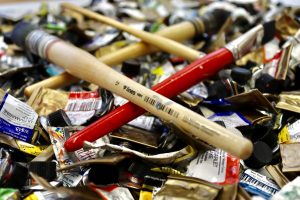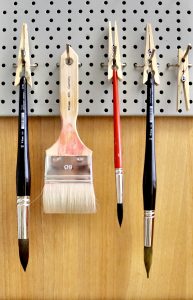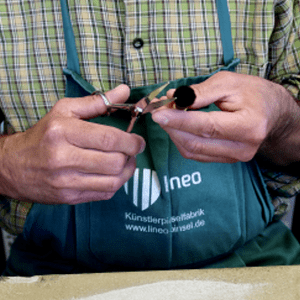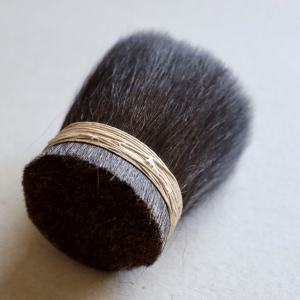Good brushes are an investment and always worth their money. It goes without saying that caring and cleaning artist brushes are essentials. High-quality brushes will definitely last longer and perform better if they are taken good care of. There are a few “rules” for how to treat artist brushes correctly:
Keep them clean while painting
Even wet paint is sometimes quite hard to remove from your brushes ferrule. Once the paint is dry, this might get even more difficult. Luckily there is an easy solution for this problem. Just try not to immerse your brush up to the ferrule and you will be safe.
During painting its also useful to always have a soft rag or paper towels at hand. You can use them to remove excess paint from your brushes.
Don’t soak your brush too long
Try to avoid leaving your brushes soaking in water or spirits for too long. It can damage the delicate hairs and might affect the quality of the glue and the handle.
Don’t let them rest on their head
Never let your brushes rest on their head. There are so many ways to avoid the damage this is going do to your brushes hair.
How to clean your brushes
After painting with watercolor and acrylic paint, mild soap and water are all you need. Brushes should be cleaned right after painting as long as the paint is still wet. Rinse the brushes, soap them carefully and rinse them again until there is no more paint coming out of the head.
If you were using oil paint, your brushes should be wiped clean first. Just use some paper towel for this before cleaning the brushes with mineral spirits. After this, we recommend using fat-restoring curd soap and water. The curd soap will help maintain the natural characteristics of the brushes hairs.

Important: Make sure that all residual paint is also removed from the edge of the ferrule. If this is not done properly, the tip will not be able to hold an optimal shape.
How to dry and store artist brushes
After washing your brushes, gently press out excess water with a soft towel and shape a nice tip with your fingers. For drying, put your brushes on a clean rag or some paper towel at room temperature. You can also put them hanging with their heads down. (this is our recommended way for drying brushes) Never dry your brushes by placing them on a radiator or with the aid of sunlight of hot air. This might damage hairs, glue and the wooden handle and will affect the brushes quality.
Please do not place the protective brush hair cover on the brush while the hairs are still wet. We recommend only using the plastic cover for protection during transport. The protective cover is not necessary for storage.



